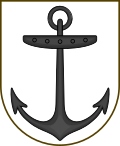Mariager
| Mariager | ||||
|
||||
| Basic data | ||||
|---|---|---|---|---|
| State : |
|
|||
| Region : | North Jylland | |||
| Region : | North Jylland | |||
|
Municipality (since 2007) : |
Mariagerfjord | |||
| Coordinates : | 56 ° 39 ′ N , 9 ° 59 ′ E | |||
|
Population : (2020) |
2,537 | |||
| Postal code : | 9550 | |||
 Monastery church and convent building |
||||
Mariager ( German "Marienacker" ) is located on the south bank of the comparatively deep fjord of the same name and is a small Jutland town with 2537 inhabitants (as of January 1, 2020) and a port . Mariager belonged to the municipal reform on 1 January 2007 for Århus Amt and was the headquarters of the homonymous municipality . Since the local government reform, Mariager has belonged to the Mariagerfjord municipality in the Nordjylland region and, among the settlement centers of the municipality, stands clearly behind the six times larger Hobro .
In Mariager roses are grown and salt stores are flushed out underground, which is why Mariager is known in Denmark as the city of roses (large nurseries) and salt (salt museum).
Meesres Bay Mariagerfjord
The Mariagerfjord is about 30 km in length and is the longest fjord on the east coast of Jutland. Like the Schlei , it was created through a tunnel valley , therefore narrow and deep, 30 m deep in the middle. He is rich in eels .
history
In the well-preserved old town, the St. Peders Church, as well as the church ruins in the nearby village of Hou, can only be seen as a foundation wall. The early history of the place is closely linked to the monastery of the Birgittine Order, built at the end of the 15th century, whose monastery church now serves as the town parish church. Mariager was granted city rights in 1592 and flourished.
Attractions
- Klosterkirche, white- coated Gothic brick church from the end of the 15th century.
- The "Klosteret" is the last surviving convent building of the Koster, a silted Gothic brick building from the 2nd half of the 15th century. In 1891 it came into government hands and was converted into a courthouse.
- Munkholm (Eng. Mönchs-Holm ) is a park in the southern part of Mariager with forest and the healing spring "Helligkilden" ( Holy Spring ), which is now called Helenenquelle.
- Denmark's largest Bronze Age barrow at the Hohøj viewpoint near the city.
- A museum iron bus runs from Mariager to Handest (15 km) in summer.
- The paddle steamer "Svanen" operates on the Mariagerfjord .
In the extensive municipal area there are numerous prehistoric and early historical traces from the Stone Age to the Viking Age in the area, especially along the south side of the Mariagerfjord:
- Jordhøj and Ormehøj as well as the easily accessible 40 m long and two-chamber Kongehøjen near Voldstedlund are megalithic sites north of the road to Katbjerg. To the east of Assens is the Ballegård dolmen .
- Rune stones found in the churches of Dalbyover, Glenstrup, Spenstrup, and Tørslev Vester Tørslev and Kjellerupgård .
- a cup stone lies in the field southwest of Vester Tørslev.
- Stone boxes ( Danish Sten- or Hellekisten ) lie in the heather west of Hem and in Mariager, Sødisbakke and Havndal and north of the fjord at Vive.
- Burial mounds are in the heather to the west and north of Hem.
- in Udbyneder there is a village church with a pulpit and frescoes from 1650
- on the other side of the fjord is the Romanesque church of Oue with medieval frescoes and the Romanesque church of Vive with its important interior
- 3 km further north is the park of Overgard Castle near the mouth of the fjord
- 12 km west of Mariager at the end of the fjord is Hobro and south-west of this place is the restored Viking castle Fyrkat , which Sven Gabelbart had built. To the west of Hobro are the passage graves of Snæbum .
literature
- Ingrid Falktoft Anderson: Vejviser til Danmarks oldtid . 1994, ISBN 87-89531-10-8 p. 158
- Karen Marie Christensen: Archaeological Sites and Monuments in the Mariager Area . Ed .: Arhus Office. 1994, ISBN 978-87-90099-08-4 .
Individual evidence
- ↑ a b Statistics Banks -> Befolkning og valg -> BY1: Folketal January 1st efter byområde, alder og køn (Danish)

